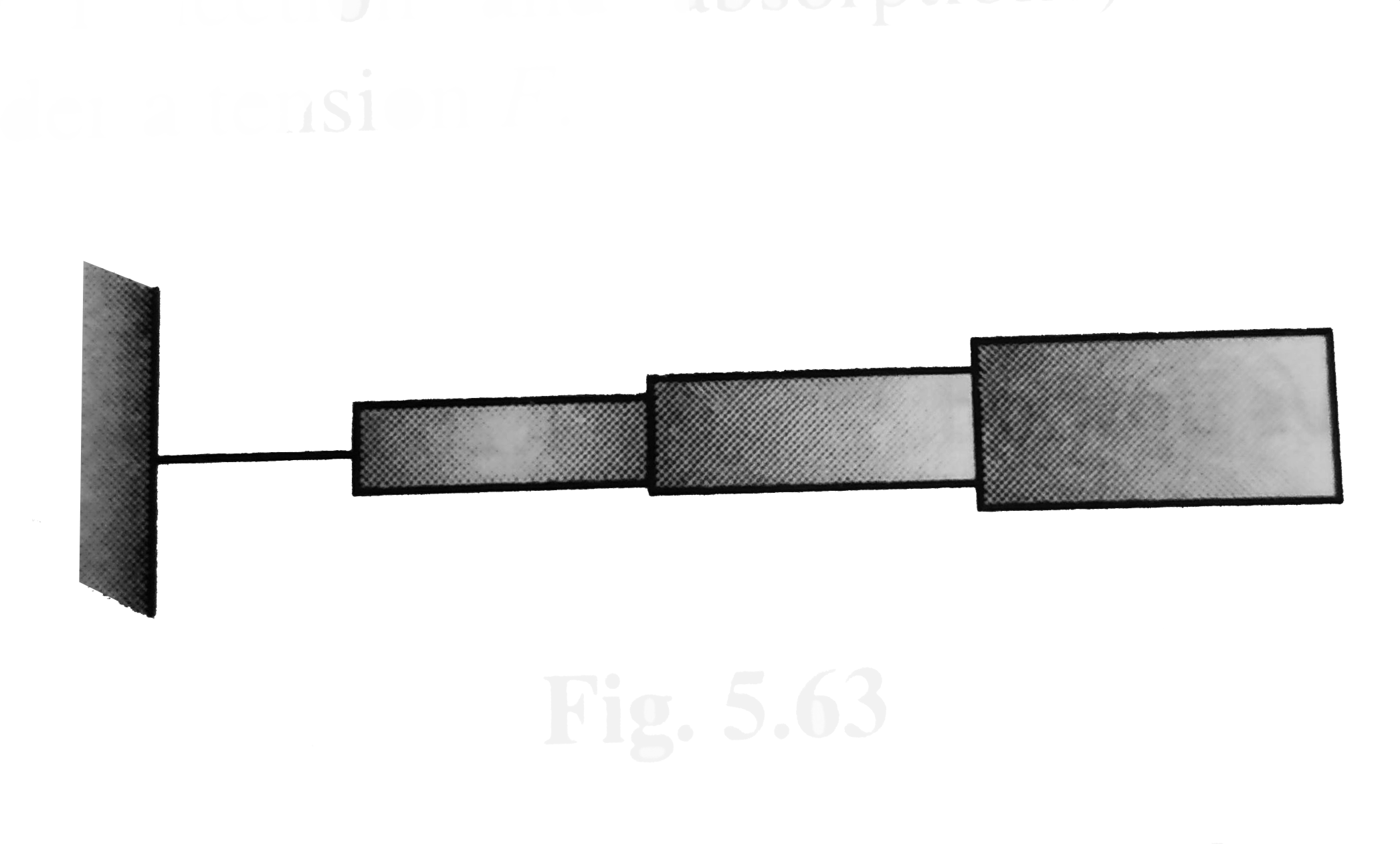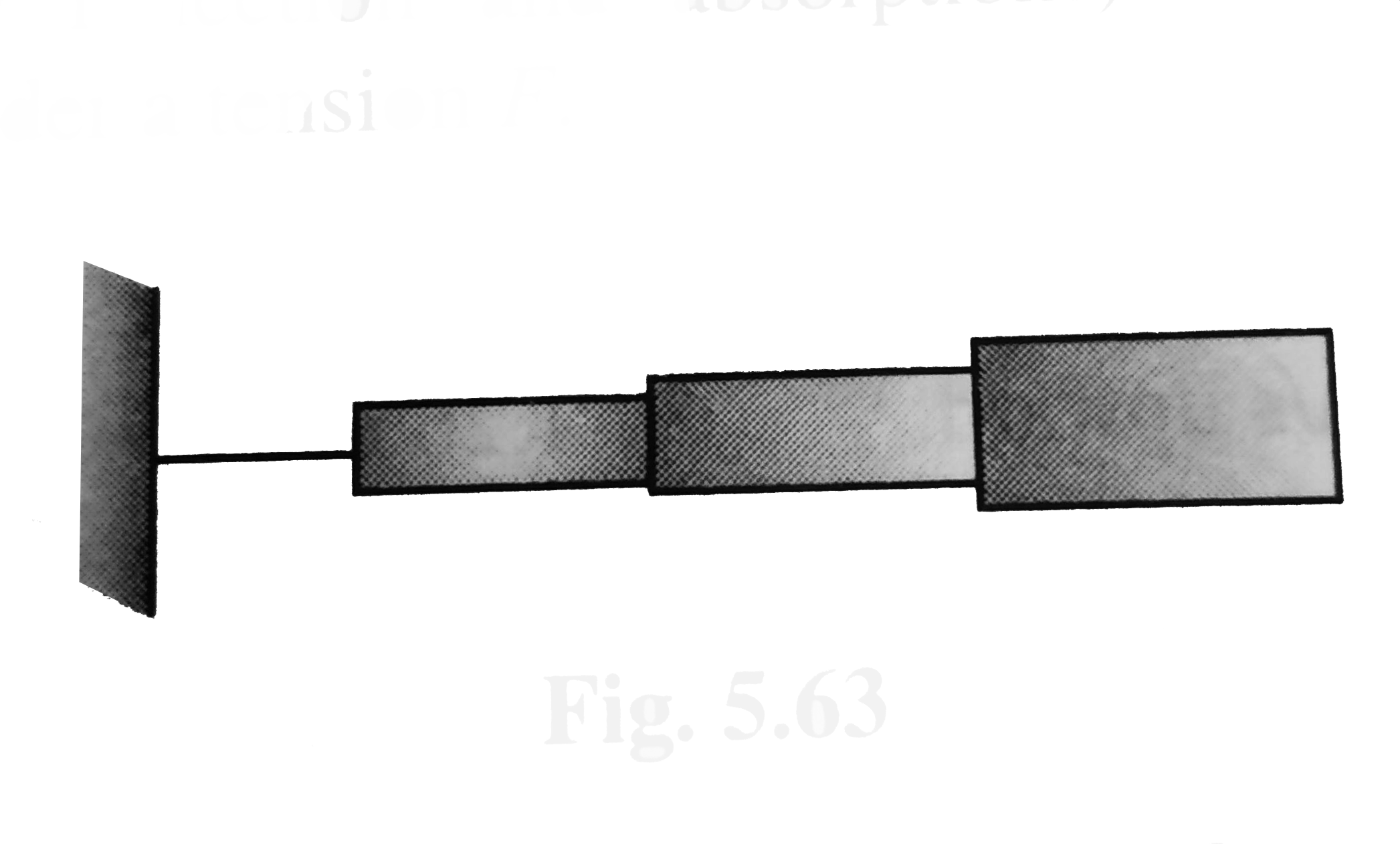Three pieces of string, each of length L, are joined together end-to-end, to make a combined string of length 3L. The first piece of string has mass per unit length μ1, the second piece has mass per unit length μ2=4μ1 and the third piece has mass per unit length μ3=μ1/4 .
(a) If the combined string is under tension F, how much time does it take a transverse wave to travel the entire length 3L? Give your answer in terms of L,F and μ1 .
(b) Does your answer to part (a) depend on the order in which the three piece are joined together? Explain.
The correct Answer is:A, B
To solve the problem step-by-step, we will analyze the situation of the three pieces of string joined together and calculate the time taken for a transverse wave to travel the entire length of the combined string.
1. Wave Speed Formula:
The speed of a transverse wave on a string is given by:
v=√Fμ
where F is the tension and μ is the mass per unit length.
2. Calculate Wave Speeds for Each Piece:
- For the first piece:
v1=√Fμ1
- For the second piece:
v2=√F4μ1=12√Fμ1=v12
- For the third piece:
v3=
⎷Fμ14=2√Fμ1=2v1
3. Calculate Time Taken for Each Piece:
The time taken for a wave to travel a distance d is given by:
t=dv
- For the first piece (length L):
t1=Lv1
- For the second piece (length L):
t2=Lv2=Lv12=2Lv1
- For the third piece (length L):
t3=Lv3=L2v1=L2v1
4. Total Time Taken:
The total time taken for the wave to travel the entire length 3L is:
Ttotal=t1+t2+t3=Lv1+2Lv1+L2v1
To simplify:
Ttotal=(1+2+12)Lv1=7L2v1
Substituting v1=√Fμ1:
Ttotal=7L2√Fμ1=7L√μ12√F
Part (b): Dependence on the order of joining the pieces
The time taken for the wave to travel the entire length of the string does not depend on the order in which the pieces are joined. This is because the total time is a function of the individual lengths and their respective mass densities. The wave speed is determined by the tension and mass per unit length of each segment, and since these properties are intrinsic to each piece, the total time remains the same regardless of the arrangement.
Final Answers:
(a) The time taken for a transverse wave to travel the entire length 3L is:
Ttotal=7L√μ12√F
(b) The answer does not depend on the order in which the three pieces are joined together.
The speed of a transverse wave on a string is given by:
v=√Fμ
where F is the tension and μ is the mass per unit length.
- For the first piece:
v1=√Fμ1
- For the second piece:
v2=√F4μ1=12√Fμ1=v12
- For the third piece:
v3=
⎷Fμ14=2√Fμ1=2v1
The time taken for a wave to travel a distance d is given by:
t=dv
- For the first piece (length L):
t1=Lv1
- For the second piece (length L):
t2=Lv2=Lv12=2Lv1
- For the third piece (length L):
t3=Lv3=L2v1=L2v1
The total time taken for the wave to travel the entire length 3L is:
Ttotal=t1+t2+t3=Lv1+2Lv1+L2v1
To simplify:
Ttotal=(1+2+12)Lv1=7L2v1
Substituting v1=√Fμ1:
Ttotal=7L2√Fμ1=7L√μ12√F
(a) The time taken for a transverse wave to travel the entire length 3L is:
Ttotal=7L√μ12√F
Topper's Solved these Questions
- SUPERPOSITION OF WAVESBook:DC PANDEY ENGLISHChapter:SUPERPOSITION OF WAVESExercise:Level 2 Comprehension Based
Explore 3 Videos
- SOUND WAVESBook:DC PANDEY ENGLISHChapter:SOUND WAVESExercise:Exercise 19.7
Explore 4 Videos
- THERMOMETRY THERMAL EXPANSION AND KINETIC THEORY OF GASESBook:DC PANDEY ENGLISHChapter:THERMOMETRY THERMAL EXPANSION AND KINETIC THEORY OF GASESExercise:Medical entrance gallary
Explore 30 Videos
Similar Questions
A string of length L consists of two distinct sections. The left half has linear mass density μ1=μ0/2 while the right half has linear mass density μ2=3μ0 . Tension in the string is F0 . The time required for a transverse wave pulse to travel from one end of the string to the other is
View SolutionCalculate the time taken for a disturbance to pass through a string of length I and of mass per unit length m when the tension in the string is mI2gN.
View SolutionFour pieces of string of length L are joined end to end to make a long string of length 4L. The linear mass density of the strings are μ,4μ,9μand16μ, respectively. One end of the combined string is tied to a fixed support and a transverse wave has been generated at the other end having frequency f (ignore any reflection and absorption). string has been stretched under a tension F. Find the time taken by wave to reach from source end to fixed end.

View SolutionString-1 is connected with string-2. The mass per unit length in string-1 is μ1 and the mass per unit length in string-2 is 4μ1. The tension in the strings is T. A travelling wave is coming from the left. What fraction of the energy in the incident wave goes into string-2 ?

View SolutionThe frequency of vibration of string depends on the length L between the nodes, the tension F in the string and its mass per unit length m. Guess the expression for its frequency from dimensional analysis.
View SolutionA straight rod of length L has one of its end at the origin and the other at X=L. If the mass per unit length of the rod is given by Ax where A is constant, where is its centre of mass?
View SolutionA straight rod of length L has one of its end at the origin and the other at X=L. If the mass per unit length of the rod is given by Ax where A is constant, where is its centre of mass?
View SolutionA straight rod of length L has one of its end at the origin and the other at X=L. If the mass per unit length of the rod is given by Ax where A is constant, where is its centre of mass?
View SolutionFour pieces of string of length L are joined end to end to make a long string of length 4L. The linear mass density of the strings are μ,4μ,9μand16μ, respectively. One end of the combined string is tied to a fixed support and a transverse wave has been generated at the other end having frequency f (ignore any reflection and absorption). string has been stretched under a tension F.

Find the ratio of wavelength of the wave on four string, starting from right hand side.
View SolutionDerive an expression for the velocity of pulse in a in stretched in string under a tension T and μ is the mass per unit length of the sting.
View Solution